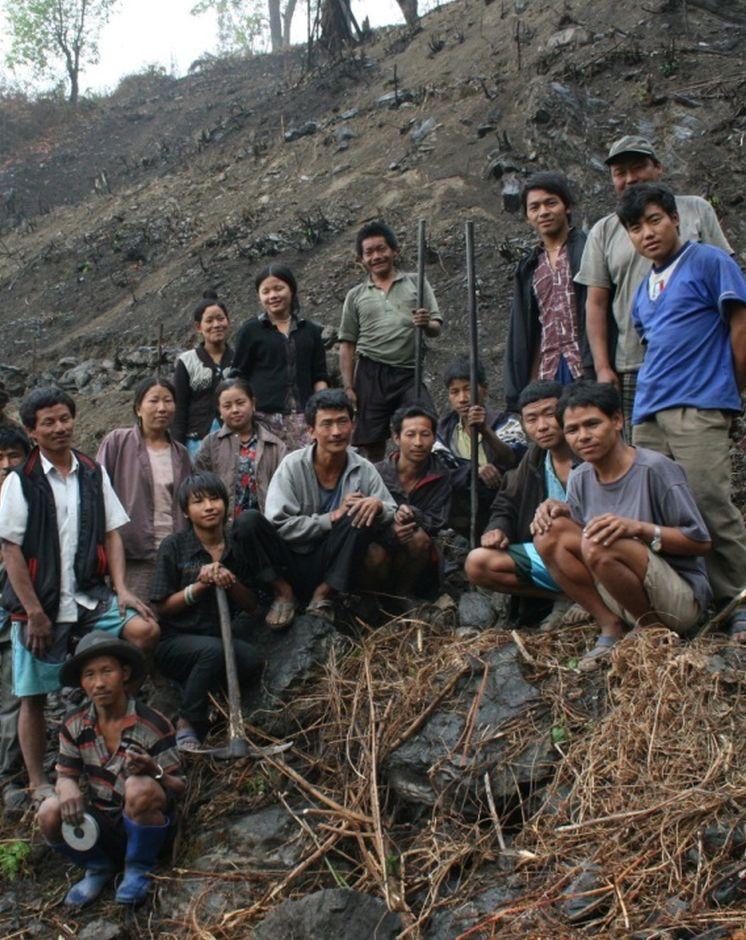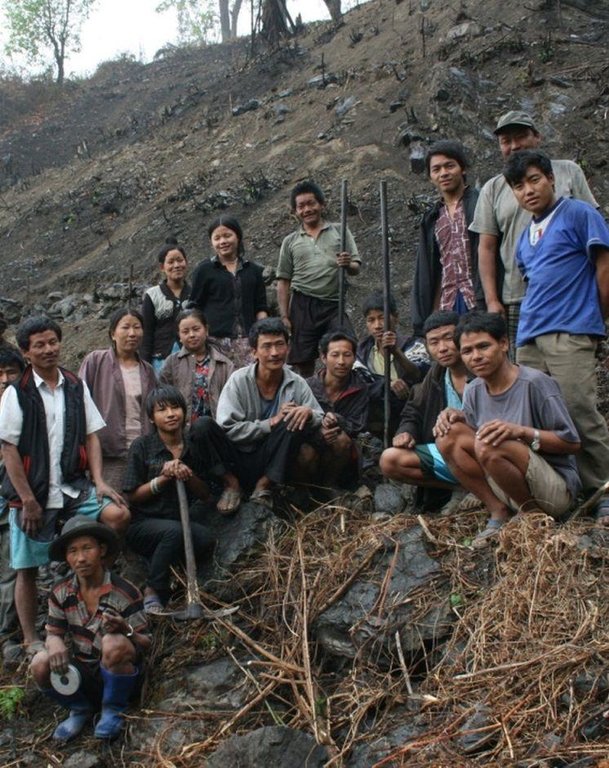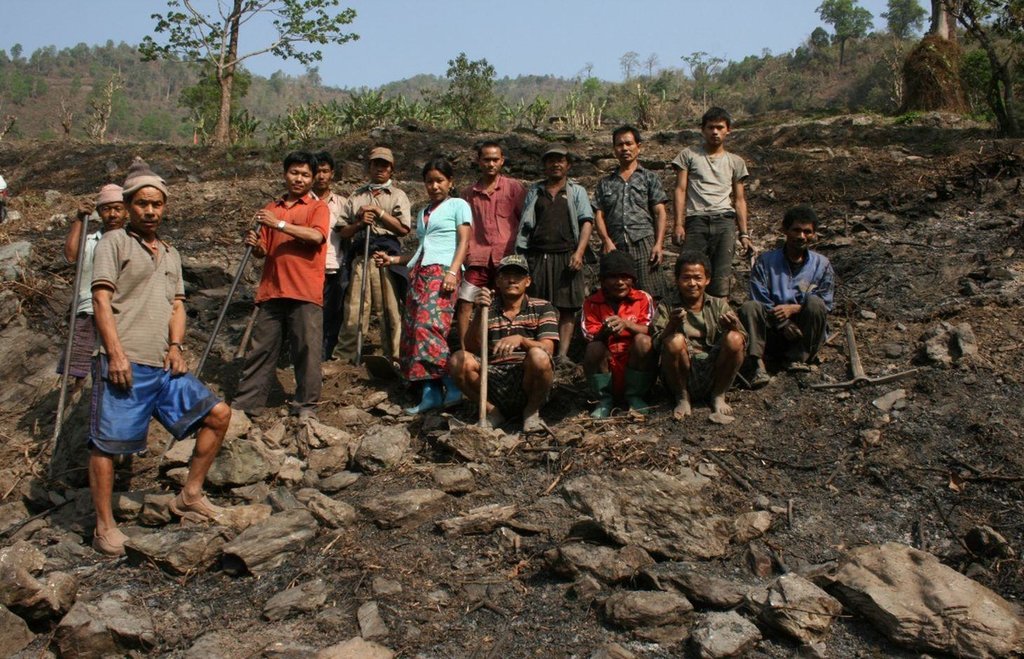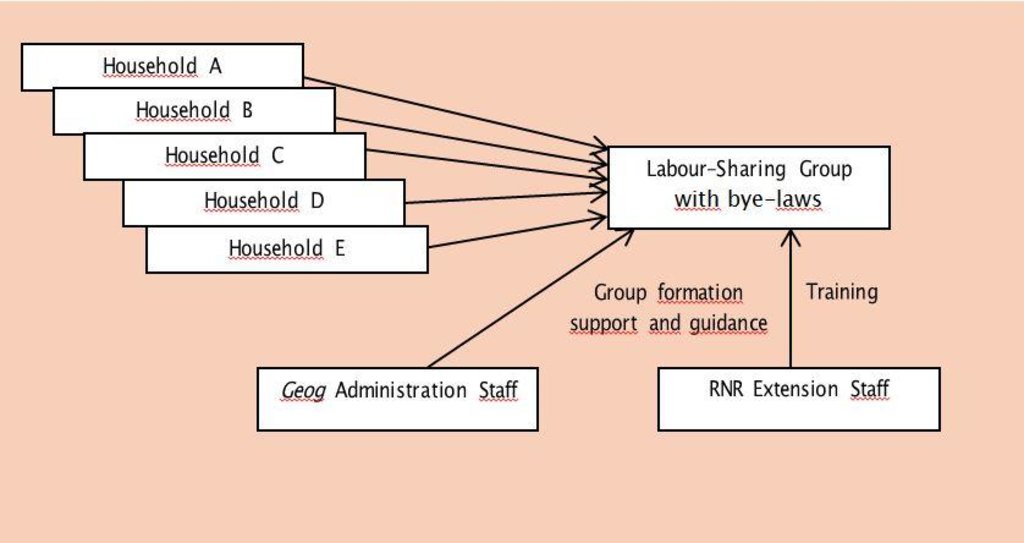SLM Labour-Sharing Group [Bhoutan]
- Création :
- Mise à jour :
- Compilateur : Karma Dorji
- Rédacteur : –
- Examinateur : Fabian Ottiger
approaches_2491 - Bhoutan
Voir les sections
Développer tout Réduire tout1. Informations générales
1.2 Coordonnées des personnes-ressources et des institutions impliquées dans l'évaluation et la documentation de l'Approche
Nom du ou des institutions qui ont facilité la documentation/ l'évaluation de l'Approche (si pertinent)
MoA (MoA) - BhoutanNom du ou des institutions qui ont facilité la documentation/ l'évaluation de l'Approche (si pertinent)
National Soil Services Centre (National Soil Services Centre) - Bhoutan1.3 Conditions relatives à l'utilisation par WOCAT des données documentées
Quand les données ont-elles été compilées (sur le terrain)?
21/03/2011
Le compilateur et la(les) personne(s) ressource(s) acceptent les conditions relatives à l'utilisation par WOCAT des données documentées:
Oui
1.4 Références au(x) questionnaire(s) sur les Technologies de GDT
2. Description de l'Approche de GDT
2.1 Courte description de l'Approche
Labour-sharing group at village and sub-village level to ease the labour constraint faced by many households.
2.2 Description détaillée de l'Approche
Description détaillée de l'Approche:
Aims / objectives: A labour-sharing group is a pool of land-users, who work on rotation basis on the plots of the different group members and replaces the conventional approach of an individual land user carrying out a specific SLM intervention. An important constraint for effective implementation of SLM interventions is the lack of sufficient labour force at household level. To tackle this key issue, groups are formed at village and sub-village level to enable these households to take up the relatively labour-intensive SLM activities, such as stone bunding, bench terracing, stone check dam construction, water source protection works or grass hedgerow development.
Methods: The labour-sharing group is given an initial practical training on the basics of the SLM intervention, which start with hands-on work on the land of a group member, preferably that of a vulnerable household, which otherwise would have difficulty to provide sufficient labour to take up the activity. Labour-sharing groups therefore facilitate the inclusion of vulnerable households, especially female-headed and small families, in the implementation of labour-intensive SLM inter-ventions. In addition to the technical guidance provided by the extension staff, support is given to the group formation process, such as drafting of informal by-laws and group management.
Stages of implementation: Labour-sharing groups enable households to carry out key SLM interventions more effectively and efficiently enabling them to cover as compared to individual household approach. Other co-benefits reported are the improved community sense and enhanced social cohesion, because the exchange of experiences and collaboration builds mutual trust. Working in a group eases hard physical work, such as carrying and breaking large boulders and is perceived to be much more enjoyable than working alone or in a small household setting.
Role of stakeholders: Groups that were formed for the implementation of a specific SLM activity often continue carrying our other planned SLM interventions in a group. In some villages communities reported that they had lost the former practice of labour-sharing, but that with reintroduction by the project their community sense has been rejuvenated. Sustainability of the labour-sharing approach has to be proven post-project. Additional costs are very limited and are restricted to group formation guidance and some additional group support, such as tool sets and more incentives as more land will be converted by the group approach.
2.3 Photos de l'approche
2.5 Pays/ région/ lieux où l'Approche a été appliquée
Pays:
Bhoutan
Région/ Etat/ Province:
Chhukha Dzongkhag
Autres spécifications du lieu :
Logchina geog, Amallay chiog
2.6 Dates de début et de fin de l'Approche
Indiquez l'année de démarrage:
2009
Date (année) de fin de l'Approche (si l'Approche n'est plus appliquée):
2012
2.7 Type d'Approche
- fondé sur un projet/ programme
2.8 Principaux objectifs de l'Approche
The Approach focused on SLM only
- To ease the existing labour constraint of individual households by pooling labour force into a common pool, ensuring a more time-efficient labour approach, enabling the group to convert larger areas of land.
- To facilitate the inclusion of vulnerable households in more labour-intensive long-term SLM interventions, for which they otherwise would not have the meansto participate.
- To improve community cohesion through improved trust, understanding, social fencing and “labour joy” (“it is much more fun to work in a group than to sweat individually”).
The SLM Approach addressed the following problems: - SLM interventions, as prioritized in chiog SLM action plan, are very labour-intensive, while labour is increasingly becoming a serious constraint in many rural areas of Bhutan, because of rural-urban migration, off-farm labour and other developmental activities.
- Vulnerable households, single-headed families and poorest families, have often the most difficulty providing sufficient labour for long-term SLM interventions
- Communities often face problems in achieving the targeted area of land to be converted to a more sustainable SLM practice, because of labour shortage.
2.9 Conditions favorisant ou entravant la mise en œuvre de la(des) Technologie(s) appliquée(s) sous l'Approche
normes et valeurs sociales/ culturelles/ religieuses
- entrave
Some issues with households who do not share sufficient labour / fail to show up
Treatment through the SLM Approach: Informal by-laws, penalty system, social fencing
cadre juridique (régime foncier, droits d'utilisation des terres et de l'eau)
- favorise
The existing land ownership, land use rights / water rights greatly helped the approach implementation: Individual titled land tenure greatly facilitates motivation and commitment of households to participate in group approach as they are direct beneficiaries.
charge de travail, disponibilité de la main-d'œuvre
- entrave
SLM interventions often require considerable hard physical labour, in a society where labour force increasingly is becoming scarcer.
Treatment through the SLM Approach: Pool individual households in a group and work on rotation basis on each other’s land
3. Participation et rôles des parties prenantes impliquées dans l'Approche
3.1 Parties prenantes impliquées dans l'Approche et rôles
- exploitants locaux des terres / communautés locales
self initiative during planning cycle
Slight differences in participation level in the most physically challenging activities such as stone bunding, but also partly culturally determined if there is gender bias in participation. In less physically demanding activities participation is equally divided.The most vulnerable households are included in the labour-sharing group, just as the “better off” families; inclusion of vulnerable households is definite advantage of approach, and an important objective.
- Spécialistes de la GDT/ conseillers agricoles
- gouvernement local
Local government (geog staff, chiog representatives) and local community
- gouvernement national (planificateurs, décideurs)
3.2 Participation des exploitants locaux des terres/ communautés locales aux différentes phases de l'Approche
| Participation des exploitants locaux des terres/ communautés locales | Spécifiez qui était impliqué et décrivez les activités | |
|---|---|---|
| initiation/ motivation | interactive | Participatory SLM Action Planning |
| planification | interactive | Participatory SLM Action Planning; Schedule of rotation compiled by group members |
| mise en œuvre | interactive | Training / capacity building at kick-off of group formation process; stone bunding, hedgerow establishment, bench terracing, stone check dam construction, bamboo and tree plantation, water source protection works and grass strip establishment |
| suivi/ évaluation | interactive | Participatory Monitoring & Evaluation meetings to give feedback and make adjustments / give guidance |
| Research | aucun |
3.3 Diagramme/ organigramme (si disponible)
Description:
Labour-sharing group and its governance
Auteur:
Hans van Noord (Schoutenkamp 43 Heteren The Netherlands)
3.4 Prises de décision pour la sélection de la Technologie/ des Technologies
Indiquez qui a décidé de la sélection de la Technologie/ des Technologies à mettre en œuvre:
- principalement les exploitants des terres soutenus par des spécialistes de la GDT
Expliquez:
Decisions on the method of implementing the SLM Technology were made by mainly by land users supported by SLM specialists
4. Soutien technique, renforcement des capacités et gestion des connaissances
4.1 Renforcement des capacités/ formation
Une formation a-t-elle été dispensée aux exploitants des terres/ autres parties prenantes?
Oui
Spécifiez qui a été formé:
- exploitants des terres
Formats de la formation:
- sur le tas
- entre agriculteurs (d'exploitants à exploitants)
- zones de démonstration
Thèmes abordés:
Training programme for specific SLM interventions, carried out by the labour-sharing group after initial capacity building and hands-on practice sessions; additional group formation support and guidance by the municipality administration staff and extension staff.
4.2 Service de conseils
Les exploitants des terres ont-ils accès à un service de conseils?
Oui
Spécifiez si le service de conseils est fourni:
- dans les champs des exploitants?
- dans des centres permanents
Décrivez/ commentez:
Name of method used for advisory service: Group formation process guidance; Key elements: by-law formulation, demo trainings, exchange visit; By extension staff and geog administration staff in group formation process and during ad hoc visits and regular participatory M & E meetings.
Advisory service is quite adequate to ensure the continuation of land conservation activities; Some need for refreshing/additional training of SLM techniques
4.3 Renforcement des institutions (développement organisationnel)
Des institutions ont elles été mises en place ou renforcées par le biais de l'Approche?
- oui, beaucoup
Spécifiez à quel(s) niveau(x), ces institutions ont été renforcées ou mises en place:
- local
Précisez le type de soutien:
- financier
- renforcement des capacités/ formation
- équipement
Donnez plus de détails:
Group formation process guidance: training and continued support by extension and geog administration staff.
4.4 Suivi et évaluation
Le suivi et l'évaluation font ils partie de l'Approche? :
Oui
Commentaires:
bio-physical aspects were regular monitored by project staff, government, land users through measurements; indicators: Regular measurements by project staff and group members: area converted, of dams built etc.
technical aspects were regular monitored by project staff, government, land users through observations; indicators: Regular observations by project staff and group members: implementation according to technical guidelines (distances between bunds/hedges, survival rate of seedlings etc.
socio-cultural aspects were regular monitored by project staff, government, land users through observations; indicators: Regular observations by project and geog administration staff and group members regarding group functioning and possible conflicts (drafting of by-laws, rules etc.)
economic / production aspects were regular monitored by project staff, land users through measurements; indicators: Regular measurements by project staff and group members: crop yield, production area increase
area treated aspects were regular monitored by project staff, land users through measurements; indicators: Regular measurements by project staff and group members: area treated
no. of land users involved aspects were None monitored by project staff, land users through measurements; indicators: Regular measurements by project staff and group members: # of households
management of Approach aspects were None monitored by project staff, government, land users through observations; indicators: Regular M & E meetings with project and geog administration staff and group members
There were few changes in the Approach as a result of monitoring and evaluation: Drafting and adoption of group by-laws to regulate agreements and as enforcement of “social fencing”
There were few changes in the Technology as a result of monitoring and evaluation: slight changes in technical guidelines after group feedback.
5. Financement et soutien matériel externe
5.1 Budget annuel de la composante GDT de l'Approche
Si le budget annuel précis n'est pas connu, indiquez une fourchette:
- < 2 000
Commentez (par ex. principales sources de financement/ principaux bailleurs de fonds):
Approach costs were met by the following donors: government (SLMP project support: tools, training, incentives): 5.0%; local community / land user(s) (labour contribution): 95.0%
5.2 Soutiens financiers/ matériels fournis aux exploitants des terres
Les exploitants des terres ont-ils reçu un soutien financier/ matériel pour la mise en œuvre de la Technologie/ des Technologies?
Oui
Si oui, spécifiez le(s) type(s) de soutien, les conditions et les fournisseurs:
Incentive per area converted to sustainable SLM practice and seeds/seedlings.
5.3 Subventions pour des intrants spécifiques (incluant la main d'œuvre)
- équipement
| Spécifiez les intrants subventionnés | Dans quelle mesure | Spécifiez les subventions |
|---|---|---|
| outils | entièrement financé | |
- intrants agricoles
| Spécifiez les intrants subventionnés | Dans quelle mesure | Spécifiez les subventions |
|---|---|---|
| semences | en partie financé | maize, mustard, potato, wheat, paddy, vegetables |
Commentaires:
Incentives cover mainly labour contribution as provided by the group members and is mostly only a minor fraction of the actual labour costs.
5.4 Crédits
Des crédits ont-ils été alloués à travers l'Approche pour les activités de GDT?
Non
6. Analyses d'impact et conclusions
6.1 Impacts de l'Approche
Est-ce que l'Approche a aidé les exploitants des terres à mettre en œuvre et entretenir les Technologies de GDT?
- Non
- Oui, un peu
- Oui, modérément
- Oui, beaucoup
Labour-sharing has resulted in the possibility to convert/treat larger areas per working day and has made the work much easier (lifting of heavy stones etc.). More land has now become cultivated through labour-sharing group involvement as could have been done through individual households.
Est-ce que l'Approche a autonomisé les groupes socialement et économiquement défavorisés?
- Non
- Oui, un peu
- Oui, modérément
- Oui, beaucoup
Targeted inclusion of vulnerable households in group, even if they have not sufficient labour to contribute to labour pool; hands-on training starts on land of most vulnerable/poor households to give them first benefit.
Did other land users / projects adopt the Approach?
- Non
- Oui, un peu
- Oui, modérément
- Oui, beaucoup
Other villages have followed the example of the initial groups.
Did the Approach lead to improved livelihoods / human well-being?
- Non
- Oui, un peu
- Oui, modérément
- Oui, beaucoup
Group members express satisfaction over improved social cohesion and interaction because of built trust and understanding and social bonding; group work has contributed to enhanced food self-sufficiency.
Did the Approach help to alleviate poverty?
- Non
- Oui, un peu
- Oui, modérément
- Oui, beaucoup
Through improved food self-sufficiency, increased production area/improved cropland area and targeted inclusion of most vulnerable households that otherwise could not have participated in specific labour-intensive SLM activity
6.2 Principale motivation des exploitants des terres pour mettre en œuvre la GDT
- augmenter la production
- réduire la charge de travail
- paiements/ subventions
- affiliation à un mouvement/ projet/ groupe/ réseaux
- conscience environnementale
6.3 Durabilité des activités de l'Approche
Les exploitants des terres peuvent-ils poursuivre ce qui a été mis en œuvre par le biais de l'Approche (sans soutien extérieur)?
- oui
Si oui, décrivez de quelle manière:
Existing group approach seems well suited to continue post-project, also as it partly is a rejuvenated traditional practice to share labour in a community group.
6.4 Points forts/ avantages de l'Approche
| Points forts/ avantages/ possibilités du point de vue de l'exploitant des terres |
|---|
|
Eases work (breaking stones, carrying etc.). A-frame running helps to have better lines. Continuous smooth work wit many Social cohesion / experience sharing (How to sustain/ enhance this strength: Continuation of group work Continuation of group work Continued group monitoring and guidance) |
| Points forts/ avantages/ possibilités du point de vue du compilateur ou d'une autre personne ressource clé |
|---|
|
Tackles main issue of labour shortage and eases hard physical work (breaking stones, carrying/lifting boulders etc.) Enhances social cohesion and group spirit / community sense; promotes exchange of experiences Facilitates conversion of larger areas of slope segments treated with SLM practices Preferred approach to enhance inclusion of most vulnerable households in labour-intensive SLM practices (How to sustain/ enhance this strength: Continued group monitoring and guidance Continued group monitoring and guidance Continued group monitoring and guidance Start hands-on training work on land of these vulnerable households to give them first benefit) |
6.5 Faiblesses/ inconvénients de l'Approche et moyens de les surmonter
| Faiblesses/ inconvénients/ risques du point de vue de l’exploitant des terres | Comment peuvent-ils être surmontés? |
|---|---|
| Some conflicts in labour-sharing (after completion on their land they abscond). | Attendance register, social control, labour compensation, fines, by-laws. |
| Faiblesses/ inconvénients/ risques du point de vue du compilateur ou d'une autre personne ressource clé | Comment peuvent-ils être surmontés? |
|---|---|
|
Sustainability has yet to be proven post-project; certain dependency on incentives Loose group structure without formal leadership might threaten sustainability |
Continued group monitoring and guidance by extension and geog administration staff By-laws to formalize some agreements and enforce some penalties |
7. Références et liens
7.1 Méthodes/ sources d'information
- visites de terrain, enquêtes sur le terrain
- interviews/entretiens avec les exploitants des terres
Liens et modules
Développer tout Réduire toutLiens
Aucun lien
Modules
Aucun module trouvé






